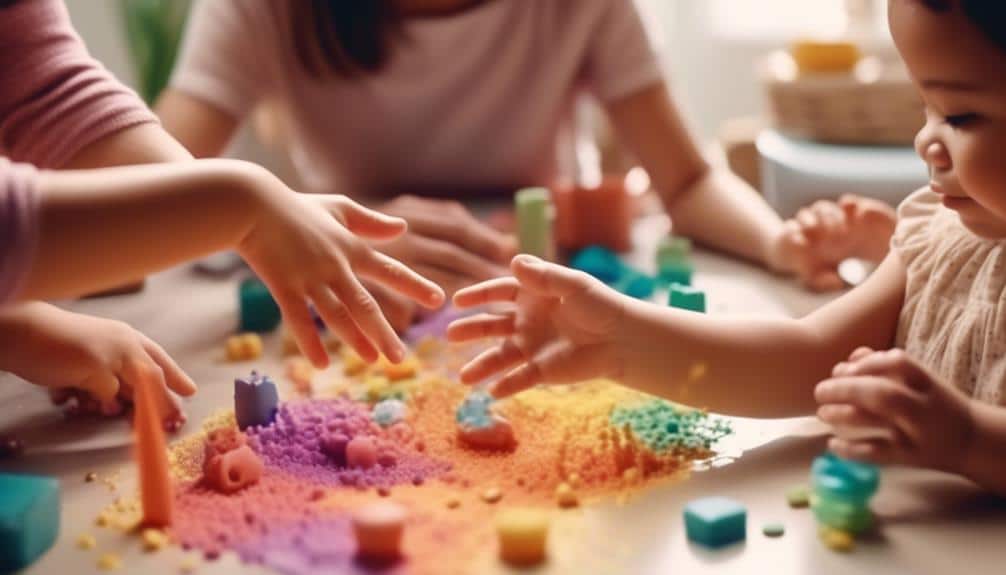When your child faces unique sensory challenges, navigating the world can be like deciphering a foreign language without a translator. Sensory Processing Disorder (SPD) therapy activities are akin to finding that translator, providing a bridge to understanding and managing those challenges. You might wonder why these activities, rather than other interventions, could be the key to unlocking your child’s potential. Sensory therapy activities are not just play; they’re structured to enhance sensory integration, which is crucial for children who experience the world more intensely or with less clarity than their peers. They’re designed to help your child develop fine motor skills, regulate their emotions, and interact socially in a way tailored just for them.
As you consider the options for supporting your child’s growth, remember that these activities could be a cornerstone for their development, offering a compelling blend of therapy and joy. Remember that the path to improved well-being often begins with understanding the tools at your disposal.
Key Takeaways
- Sensory therapy activities can help children with Sensory Processing Disorder (SPD) navigate their sensory experiences and improve sensory processing.
- These activities can enhance the development of motor skills, including muscle tone, coordination, and bilateral coordination.
- Sensory therapy activities also contribute to building emotional regulation, which is crucial for children with sensory processing difficulties to navigate overwhelming emotions.
- Encouraging social interaction through sensory therapy activities can help children develop communication, cooperation, empathy, and social interaction skills.
Understanding Sensory Processing Disorder
Suppose you’re struggling to understand why your child may be overly sensitive to textures or prone to coordination difficulties. In that case, they may be experiencing Sensory Processing Disorder (SPD), a condition where the brain has trouble receiving and responding to information that comes in through the senses. SPD affects how your child’s nervous system interprets signals from their sensory systems and, crucially, how it generates appropriate responses to those signals.
When sensory information isn’t organized into appropriate responses, children may exhibit various behaviors, from aversions to certain textures to fine and gross motor skills challenges. This can be baffling and stressful, but recognizing SPD therapy is the first step towards addressing it.
Occupational therapy, particularly sensory integration therapy, offers a structured and effective way to help children navigate their sensory experiences. Children can gain better control over their responses by engaging in activities that challenge and support the nervous system. Simple, fun activities like sensory bins or homemade playdough cater to tactile exploration, helping to regulate the sensory input and integrate it more effectively. Similarly, log roll yoga can strengthen balance and coordination, reinforcing the progress made in therapy. Children with SPD can develop the skills to process sensory information more efficiently with the proper support.
Benefits of Sensory Therapy Activities
Engaging in sensory therapy activities can significantly enhance your child’s ability to regulate their emotions and responses to sensory stimuli while improving their muscle tone, coordination, and visual skills. These structured activities facilitate sensory integration, which is crucial for children with Sensory Processing Disorder. By participating in these therapies, your child is likely to experience a range of benefits:
- Improved Body Awareness and Control
- Enhanced muscle tone and postural coordination contribute to better gross and fine motor skills.
- Activities involving deep pressure help to calm and organize the sensory system.
- Development of Sensory Processing Skills
- A personalized sensory diet offers tailored stimulation that can adjust to your child’s changing needs.
- Exercises stimulating the vestibular system improve balance and understanding movement and gravity.
These sensory therapy activities not only aid in managing the challenges associated with Sensory Processing Disorder and nurture your child’s overall development. Your dedication to serving your child’s needs through these therapies can open doors to a more balanced and fulfilling sensory experience for them.
Enhancing Motor Skills Development

Developing your child’s motor skills through sensory processing activities can profoundly impact their coordination and physical abilities. Sensory processing disorder therapy activities enhance fine and gross motor skills, which are crucial for daily tasks. By engaging in these activities, you can help your child build the necessary foundation for a more coordinated and balanced body.
For instance, Log Roll Yoga improves muscle tone and enhances bilateral coordination, allowing smoother movement transitions. Sensory games, such as playing hot potato, fine-tune visual perception skills, essential for tasks requiring hand-eye coordination. Heavy work and proprioceptive activities also provide valuable muscle feedback vital for gross motor development.
Here’s a table summarizing some activities and their benefits:
| Activity Type | Target Skill | Benefit |
|---|---|---|
| Log Roll Yoga | Bilateral Coordination | Strengthens nervous system |
| Sensory Games | Fine Motor Skills | Improves visual perception |
| Proprioceptive Activities | Gross Motor | Enhances muscle feedback |
Incorporating these activities into your child’s routine can be a game-changer, providing them with the sensory integration needed to navigate their world more quickly and confidently. Remember, every child is unique, and you’re making a difference by supporting the development of their motor skills.
Building Emotional Regulation
For children grappling with sensory processing difficulties, mastering emotional regulation is critical to achieving emotional and behavioral balance. When sensory processing issues cause overwhelming emotions, it’s essential to equip these kids with the tools to navigate their feelings. Emotional regulation isn’t just about calming down at the moment; it’s about building resilience and the capacity to respond to sensory stimuli in a healthier way.
Understanding and managing emotions can also pave the way for:
- Enhanced social interactions
- Making friends becomes easier when children can interpret and express emotions appropriately.
- Collaborative play is facilitated, fostering a sense of belonging and teamwork.
- Improved coping skills
- Dealing with change or unexpected sensory input becomes less daunting.
- Stress and anxiety levels can decrease, leading to more positive experiences.
Encouraging Social Interaction

Encouraging social interaction opens opportunities for children to hone their social skills and forge meaningful connections. When you engage in sensory processing disorder therapy activities that promote social interaction, you’re not just facilitating playtime; you’re helping your child navigate the complexities of human relationships.
These activities can help children with sensory processing challenges better understand and respond to social cues, allowing them to feel more comfortable and confident in group settings. As a caregiver or professional, your role in fostering these experiences is vital.
Here’s a concise table that highlights key benefits and examples of sensory processing disorder therapy activities that encourage social interaction:
| Benefit | Activity Example | Skill Developed |
|---|---|---|
| Communication | Joint craft projects | Expressing and interpreting verbal cues |
| Cooperation | Team obstacle courses | Working together towards a common goal |
| Empathy | Role-playing games | Understanding others’ emotions |
Incorporating these activities can significantly enhance your child’s social interaction ability, making them essential developmental tools. Remember, the goal isn’t just to keep children with sensory engaged; it’s to help them thrive in social environments, building the foundation for a well-rounded future.
Promoting Cognitive Growth
As you explore sensory processing disorder therapy, it’s essential to consider activities that nurture your child’s cognitive development. Implementing sensory-rich tasks can significantly boost their learning abilities and brain development. By incorporating activities like sensory play and proprioceptive challenges, you’re addressing their sensory needs and laying the groundwork for cognitive growth.
Enhancing Brain Development
To enhance brain development and promote cognitive growth in individuals with Sensory Processing Disorder, integrating activities such as Log Roll Yoga and sensory games into daily routines can have a profound impact on their neurological and muscular systems. These sensory processing disorder therapy activities are tailored to support the following:
- Log Roll Yoga
- Balances and strengthens the nervous system
- It enhances the vestibular system, which is crucial for equilibrium
- Sensory Games and Activities
- Reinforce OT progress through interactive play
- Improve visual perception and cognitive skills
Incorporating these exercises into your care strategy can stimulate sensory integration, fostering an environment where growth is possible and encouraged. Your dedication to enhancing brain development through these therapeutic methods can help individuals with SPD navigate their world more quickly and confidently.
Boosting Learning Abilities
Building on enhanced brain development, we’ll explore how specific activities can further boost learning abilities, promoting cognitive growth in those with Sensory Processing Disorder. SPD therapy activities, like Log Roll Yoga, enhance the vestibular system and improve muscle tone, which is crucial for boosting learning abilities. Engaging in sensory games, such as hot potato and straw races, helps improve sensory coordination and oral motor skills, laying the groundwork for cognitive development.
Integrating oral-motor activities like blowing bubbles and chewing tools can help regulate emotions and develop sensory integration. Meanwhile, tactile activities, including baking and gardening, provide hands-on exploration of textures that stimulate cognitive growth. Moreover, visual activities like stringing beads and playing card-matching games sharpen the visual system, supporting your journey to improve sensory-based learning.
Fostering Independence

Encouraging children with Sensory Processing Disorder to participate in sensory activities can significantly enhance their independence, fostering a sense of self-assurance and the ability to manage their emotions and behaviors. When you choose sensory processing disorder therapy activities focused on promoting independence, you’re supporting children in building the confidence to explore and engage with their environment on their terms.
- Sensory activities prompt autonomous exploration:
- Motor activities: These encourage children to use their bodies to interact with their environment, which can improve coordination and gross motor skills.
- Planning skills: Selecting and planning what to play with helps children to make decisions and set goals independently.
By facilitating independence through sensory play and therapy, you are empowering children to:
- Develop essential life skills and adaptive behaviors.
- Foster emotional and behavioral self-regulation.
Your empathy and professional guidance in these sensory processing disorder therapy activities provide children with the tools to navigate their surroundings and learn self-care skills. Your dedication to their development serves their immediate needs and lays a foundation for a more self-sufficient and confident future.
Customizing Individual Treatment Plans
Crafting a treatment plan tailored to each child’s sensory needs lays the groundwork for more effective and engaging therapy sessions. As you develop these plans, you’re not just applying a one-size-fits-all approach but also recognizing and honoring the unique ways each child experiences sensory input. This acknowledgment is at the heart of customizing individual treatment plans.
Occupational therapy fosters a child’s ability to process and respond to sensory information. By personalizing strategies, you address a child’s specific sensory challenges and strengths. This level of customization maximizes the potential for progress, as interventions are directly aligned with the child’s unique needs.
Moreover, a customized plan isn’t static. It’s designed to be flexible, allowing for adjustments as you observe how a child responds to various sensory processing disorder therapy activities. This adaptability is crucial, ensuring that therapy remains relevant and practical throughout the child’s development.
Integrating Multi-Sensory Experiences

Integrating multi-sensory experiences into a child’s routine can significantly enhance their sensory development, offering varied stimuli that teach their nervous system to process and respond more adaptively. These sensory processing disorder therapy activities are crucial for children who struggle with sensory integration, as they encourage the development of a wide range of sensory skills.
Here’s how you can incorporate these experiences:
- Sensory bin play
- *Tactile*: Filling bins with rice, beans, or water beads
- *Visual*: Adding colorful objects to seek and sort
- Homemade playdough
- *Proprioceptive*: Kneading and shaping the dough
- *Vestibular*: Rolling out the dough while sitting on a therapy ball
These activities can improve muscle tone and coordination and enhance emotional regulation. Integrating these multi-sensory experiences into daily life means you’re not just playing but building crucial skills. It’s a way to support children’s ability to process sensory information, including helping to develop visual and auditory processing abilities.
Furthermore, incorporating these practices can complement and reinforce the progress made during formal occupational therapy sessions, ensuring consistency and continued growth in a child’s sensory development journey.
Supporting Academic Success
Sensory processing therapy activities, such as sensory bins and homemade playdough, can significantly enhance your child’s fine motor skills, directly supporting their academic performance in tasks like writing and drawing. These hands-on learning activities engage a child with sensory processing challenges and build the skills and control needed for classroom success.
Occupational therapy, which often includes sensory processing disorder therapy activities, is critical in addressing sensory integration and motor coordination. This support can lead to attention, focus, and behavior improvements, all foundational to achieving academic success. For example, engaging your child in log roll yoga can bolster their concentration and self-regulation skills, allowing them to better navigate the demands of an educational environment.
Moreover, sensory games that challenge and develop visual perception and language abilities can substantially impact your child’s learning. These activities do more than entertain; they reinforce essential skills and pave the way for academic progress. By integrating these therapeutic practices into your child’s routine, you’re not just playing but providing them with vital tools to succeed in school and beyond.
Nurturing Family Involvement

While pediatric occupational therapy with sensory activities bolsters your child’s academic skills, embracing family involvement further enhances the supportive atmosphere crucial for their development. Involving the family in sensory processing disorder therapy activities reinforces progress at home and ensures that your child receives a consistent approach to managing sensory information.
- Family involvement benefits:
- *Ensures consistency in therapy*: Regularly practicing techniques at home complements the therapist’s efforts, leading to more robust progress.
- *Promotes generalization of skills*: When you apply therapeutic strategies in various settings, your child learns to navigate different environments more efficiently.
Incorporating family into the therapy process fosters a deeper understanding of your child’s needs. It facilitates open communication between you and the therapists, creating a collaborative environment where everyone is aligned with your child’s goals.
- Empowerment through participation:
- *Enhances communication*: As you learn more about the therapy activities, you can better advocate for your child’s needs across different contexts.
- *Promotes a sense of collaboration*: Your active participation signals to your child that they are not alone on their journey, bolstering their confidence and motivation.
Frequently Asked Questions
What Are the Benefits of Sensory Play in Therapy?
Sensory play in therapy helps you develop crucial skills, from fine motor to emotional control, while providing personalized strategies to navigate sensory challenges in everyday life. It’s an empowering tool for growth and learning.
Why Do We Perform SPD Therapy?
You perform sensory stimulation therapy to help children master their sensory challenges, fostering better control over their responses and improving their overall development in a compassionate, skill-enhancing way.
Why Is Understanding Sensory Processing Important?
You’re unlocking a world of understanding; knowing sensory processing is critical to nurturing a child’s growth, ensuring they can navigate their environment and master essential life skills with confidence and ease.
Why Is Sensory Therapy Important?
You’ll find sensory therapy crucial because it helps children integrate sensory information, enhancing their ability to navigate their environment and interact with others more effectively and comfortably.
Conclusion
Sensory integration therapy is an occupational therapy that helps children with sensory processing difficulties. This condition can be seen in children with Autism Spectrum Disorder, Attention Deficit Hyperactivity Disorder, Mental Disorders, Cerebral Palsy, and other neurological or medical conditions. Sensory processing difficulties can cause children to react adversely to sensory stimuli, such as loud, sudden, or certain food textures.
The therapy involves sensory activities that help children become more aware of their bodies and their sense of personal space. They will learn to respond appropriately to sensory stimuli, which will help them to develop their motor control and balance. The therapy also helps to improve their social skills and behavior.
Parents of children with sensory challenges can incorporate sensory activities into their daily routines. Examples include playing with balls, exercise balls, or stress balls. They can also create a safe space for their child when overwhelmed. Chewy foods and seamless socks can provide sensory feedback and improve body awareness.
Sensory integration therapy is a primary treatment for children with sensory processing issues. It involves using squishy balls, ball pits, and other movement activities to improve their sense of movement and balance. The therapy also helps children develop motor integration skills, which are essential for daily activities such as writing and playing musical instruments.
With the help of an occupational therapist or a physical therapist, parents can create a treatment plan that includes sensory integration therapy. The therapy will help children reach their optimal sensory response level and reduce their stress levels. By addressing sensory hypersensitivity early on, children can improve their reactions to sensations and emotional responses, improving their quality of life.


Recent Comments